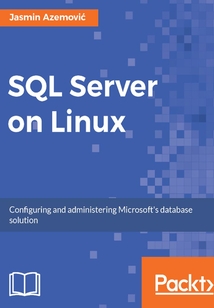舉報 

會員
SQL Server on Linux
最新章節:
Conclusion
ThisbookisfortheLinuxuserswhowanttolearnSQLServerontheirfavoriteLinuxdistributions.Itisnotimportantifyouareexperienceddatabaseuserorabeginneraswearestartingfromscratch.However,itisrecommendedthatyouhavebasicknowledgeaboutrelationalmodels.Moreadvancedreaderscanpickthechaptersoftheirinterestandstudyspecifictopicsimmediately.UsersfromWindowsplatformcanalsobenefitfromthisbooktoexpandtheirfrontiersandbecomeequallyefficientonbothplatforms.
目錄(168章)
倒序
- cover
- Title Page
- Copyright
- SQL Server on Linux
- Credits
- About the Author
- About the Reviewer
- www.PacktPub.com
- Why subscribe?
- Customer Feedback
- Preface
- What this book covers
- What you need for this book
- Who this book is for
- Conventions
- Reader feedback
- Customer support
- Downloading the example code
- Errata
- Piracy
- Questions
- Linux Distributions
- Supported Linux distributions
- openSUSE
- Installation procedure
- Kubuntu
- Installation procedure
- Summary
- Installation and Configuration
- Bash really quick start
- SQL Server installation on openSUSE
- SQL Server installation on Kubuntu
- Summary
- SQL Server Basics
- Overview of SQL Server
- Client-server architecture concepts
- SQL Server components
- How it works on Linux
- SQL Server objects
- System databases
- Database objects
- SQL Server data types
- SQL/T-SQL basics
- History of SQL/TSQL
- Types of SQL statements
- DDL - Data Definition Language
- DCL - Data Control Language
- DML - Data Manipulation Language
- Working environments and tools
- sqlcmd
- bcp
- Visual Studio code
- SQL Server Management Studio (SSMS)
- Summary
- Database in the Sandbox
- DDL statements
- Creating a new database
- Creating new tables
- DML statements
- Data manipulation
- Changing table definition
- Dropping a table
- Creating other database objects
- Creating views
- Creating stored procedures
- Creating triggers
- Summary
- Sample Databases
- Relational database concepts
- Normalization
- First normal form
- Second normal form
- Third normal form
- Northwind database
- Pubs database
- AdventureWorks database
- Installing AdventureWorks
- WideWorldImporters database
- Summary
- A Crash Course in Querying
- Retrieving and filtering data
- Retrieving data from a table
- String functions
- Exercise
- Filtering data
- Comparison operators
- String comparison
- Logical operators
- Working with NULL values
- Manipulating query output
- Overview of aggregate functions
- Aggregate functions and NULL values
- GROUP BY clause
- HAVING clause
- JOIN operators
- INNER JOIN
- OUTER JOIN
- Multiple joins
- Summary
- Backup and Recovery Operations
- SQL Server recovery models
- Simple recovery model
- Full recovery model
- Bulk-logged recovery model
- How transaction log works
- Elements of backup strategy
- Who can create backups?
- Backup media
- Types of backup
- Full database backups
- Transaction log backups
- Differential backups
- Backup and restore
- Summary
- User Management
- Authentication process
- Authorization process
- Accessing SQL Server resources
- Server-level permissions
- Database-level permissions
- Schema separation
- Summary
- Implementing Data Protection
- Crash course in cryptography
- Symmetric cryptography
- Asymmetric cryptography
- What is a key?
- SQL Server cryptographic elements
- T-SQL functions
- Certificates
- Service Master Key
- Database master key
- Transparent Data Encryption
- Backup encryption
- Symmetric encryption
- Row-level security
- Dynamic data masking
- Summary
- Indexing
- Indexing concepts
- Accessing the data
- Index structure
- Single and composite indexes
- Ascending and descending indexes
- Clustered index
- What is a heap
- Non-clustered index
- Unique indexes
- Columnstore index
- Summary
- In-Memory OLTP
- Elements of performance
- The good
- The bad
- The ugly
- What is In-Memory OLTP?
- In-Memory OLTP quick start
- How to create memory-optimized tables?
- What is natively compiled stored procedure?
- Summary
- Beyond SQL Server
- Query store
- Temporal tables
- Mssql-scripter tool
- DBFS tool
- DBeaver – third party tool
- Summary
- Conclusion 更新時間:2021-07-02 20:24:43
推薦閱讀
- Learning Neo4j
- 控糖控脂健康餐
- Android 7編程入門經典:使用Android Studio 2(第4版)
- AutoCAD VBA參數化繪圖程序開發與實戰編碼
- R Deep Learning Cookbook
- 劍指MySQL:架構、調優與運維
- Angular開發入門與實戰
- 區塊鏈國產化實踐指南:基于Fabric 2.0
- Mastering Apache Camel
- ROS機器人編程實戰
- C++17 By Example
- 樹莓派開發從零開始學:超好玩的智能小硬件制作書
- Mastering PostgreSQL 11(Second Edition)
- 情境微課開發(第2版)
- SFML Essentials
- Go Programming Cookbook(Second Edition)
- 小學生C++編程課堂(新手篇)
- HTML5+CSS3網頁布局項目化教程
- Python 3 Text Processing with NLTK 3 Cookbook
- 數據可視化實戰:使用D3設計交互式圖表(第2版)
- OCA Oracle Database 11g:SQL Fundamentals I:A Real World Certification Guide
- Neural Networks with R
- KNIME Essentials
- Java從入門到項目實戰(全程視頻版)
- Learning Highcharts
- Mastering AWS Development
- MATLAB從基礎到精通
- INSTANT HTML5 Responsive Table Design How-to
- 馴服爛代碼:在編程操練中悟道
- Android開發入門百戰經典 (程序員典藏)

